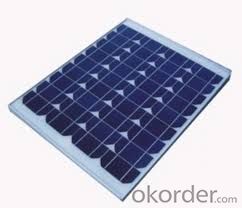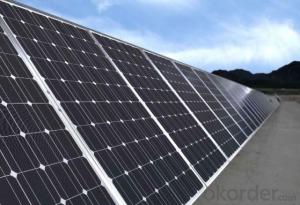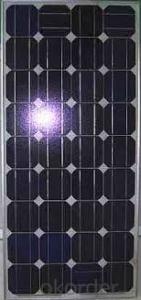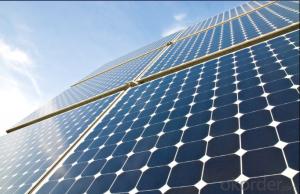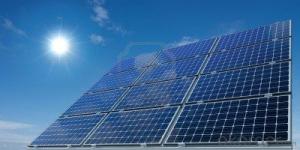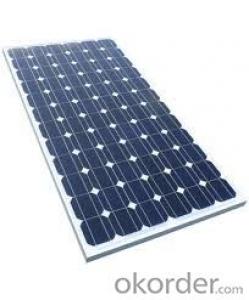International Space Station Solar Panels:Hot Sale 165W Monocrystalline Solar Panel with High Efficiency CNBM
- Loading Port:
- Qingdao
- Payment Terms:
- TT OR LC
- Min Order Qty:
- 10 set
- Supply Capability:
- 300000 set/month
OKorder Service Pledge
OKorder Financial Service
You Might Also Like
Monocrystalline Solar Panel with 165W
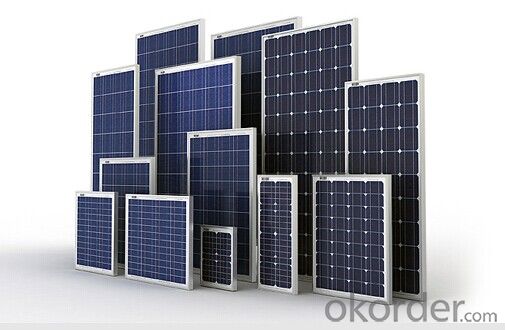
Monocrystalline Solar Modules
We offers a range of small, medium and large monocrystalline solar modules, designed for a range of requirements.
Specifications:
Tolerance | +/- 3% |
Cell | Monocrystalline silicon solar cells |
N0. of Cells | 72 (12 x 6) |
Dimension of Modules (mm) | 1581 x 809 x 40 |
Weight (kg) | 15.5 |
Limits:
Operating Temperature | -40~+85? |
Storage Temperature | -40~+85? |
Maximum System Voltage | 1000 VDC max. |
Hail Impact | Diameter of 28mm with impact speed of 86km/h |
Temperature and Coefficients:
NOCT | 48C+/-2? |
Voltage temperature coefficient (%/K) | -0.34 |
Current temperature coefficient (%/K) | 0.09 |
Power temperature coefficient (%/K) | -0.37 |
Characteristics:
Model: | SGM-160D | SGM-165D | SGM-170D |
Max-power voltage Vmp (V) | 34.5 | 35.4 | 35.8 |
Max-power current Imp (A) | 4.64 | 4.66 | 4.75 |
Open-circuit voltage Voc (V) | 41.75 | 43.6 | 43.32 |
Short-Circuit Current Isc (A) | 5.32 | 5.08 | 5.38 |
Max-power Pm(W) | 160 | 165 | 170 |
Model: | SGM-175D | SGM-180D | SGM-185D |
Max-power voltage Vmp (V) | 36.1 | 36.2 | 36.2 |
Max-power current Imp (A) | 4.85 | 4.97 | 5.11 |
Open-circuit voltage Voc (V) | 43.68 | 43.8 | 44.8 |
Short-Circuit Current Isc (A) | 5.49 | 5.48 | 5.51 |
Max-power Pm(W) | 175 | 180 | 185 |
STC: Irradiance 1000W/m2, Module temperature 25?, AM=1.5
Monocrystalline Solar Panels Specifications Range
Maximum Power (Pm) | Dimension | Weight | Operating Voltage (Vmp) | Operating Current (Imp) | Open Circuit Voltage (Voc) | Short Circuit Current (Isc) |
3W | 158x241x25mm | 0.5kg | 8.5V | 0.36A | 10.5V | 0.4A |
4W | 308x166x25mm | 0.77kg | 8.5V | 0.47A | 10.5V | 0.54A |
4W | 308.x166x25mm | 0.77kg | 16.8V | 0.24A | 21V | 0.27A |
5W | 296x215x25mm | 0.3kg | 16.8V | 0.48a | 21V | 0.54A |
10W | 286x406x25mm | 1.5kg | 16.8V | 0.59A | 21V | 0.66A |
12W | 286x406x25mm | 1.5kg | 16.8V | 0.71A | 21V | 0.8A |
14W | 286x541x25mm | 2kg | 16.8V | 0.83A | 21V | 0.96A |
16W | 286x541x25mm | 2kg | 17.2V | 0.93A | 21.5V | 0.99A |
18W | 296x541x25mm | 2.4kg | 18.8V | 1.07A | 21V | 1.2A |
20W | 296x641x25mm | 2.4kg | 17.2V | 1.15A | 21.5V | 1.24A |
24W | 541x451x25mm | 3.15kg | 16.8V | 1.14A | 21V | 1.56A |
26W | 541x451x25mm | 3.15kg | 17.2V | 1.51A | 21.5V | 1.63A |
30W | 296x966x25mm | 3.85kg | 16.8V | 1.78A | 21V | 2.03A |
36W | 541x641x35mm | 4.7kg | 16.8V | 2.14a | 21V | 2.4A |
40W | 541x641x35mm | 4.7kg | 17.2V | 2.33A | 21.5V | 2.5A |
55W | 1057x457x35mm | 6.6kg | 17.6V | 3.12A | 21.6V | 3.3A |
70W | 546x1196x35mm | 8.5kg | 16.8V | 4.15A | 21V | 4.7A |
75W | 546x1196x35mm | 8.5kg | 17.2V | 4.36A | 21.5V | 4.8A |
80W | 546x1196x35mm | 8.5kg | 17.6V | 4.55A | 21.6V | 4.9A |
110W | 1066x811x40mm | 11.8kg | 17.6V | 6.25A | 21.6V | 6.6A |
150W | 1066x811x40mm | 14kg | 34.4V | 4.36A | 43.2V | 4.7A |
- Q: If you need 9400 watts, 75 amps@ 240V, how many solar PV panels do you need?
- 75 amps @ 240VDC is 8,000 watts.
- Q: Can solar panels be used for powering Wi-Fi networks?
- Yes, solar panels can be used to power Wi-Fi networks. Solar panels convert sunlight into electricity, which can then be used to power various devices, including Wi-Fi routers. This allows for the establishment of Wi-Fi networks in remote locations or areas with limited access to electricity grids. Additionally, solar-powered Wi-Fi networks are environmentally friendly and sustainable.
- Q: Do solar panels require a backup generator?
- No, solar panels do not require a backup generator. They generate electricity directly from sunlight and can store excess energy in batteries for use when the sun is not shining.
- Q: first of all, to be honest i have totally no idea on how a solar panel works.my task is to design something like a solar powered street lamp which store sun energy during day time and convert it into electrical energy then light energy so that the lamp can work during night time.any ideas on how to design the solar panel? which can store enough or more enegry in case there is no sunlight another day. and low cost as well :D
- solar panels change light into electricity, and do NOT store power. You need a solar panel capable of enough power to keep the light on all night. And that may be 6 hours of sun and 2 hours of dark. Then you need a set of batteries large enough to hold that energy. And a charge controller to regulate the charge into the batteries. And then a light that will operate on the battery voltage, say 2 volts. This is probably not practical due to the large solar panel required, and the large batteries. But here is a few numbers. Assume a 00 watt light at 2 volts. Assume you get at least 6 hours of sun every day and the light will be on for 2 hours. That means the battery has to store 00*2=200 watt hours. divide by 2 and that is 00 amp-hours, a large auto battery size. Allowing for 20% losses in the battery and circuitry, that means you nee 400 watt hours from the solar panel. Since it has 4 hours to operate, that means it has to deliver 400/4 = 350 watts at 5 volts. So there it is: 350 watt panel 00 amp hour battery charge controller sized for above 00 watt light. If you have to allow for a day with no sun, then you need more batteries. Two nights means 2400 watt-hours, two batteries, a larger charge controller and a 2800/4 = 700 watt panel. cost: $400 for batteries $200 for charge controller $2000 for panel .
- Q: Do solar panels work with any type of heat or only sunlight? I have a bunch of little ideas floating around in my head and Id like to get them on paper but only if they really would work.Also does a concentrated amount of heat on one solar panel piece (quot;xor so) produce a higher or equal amount of electricity than a less concentration over a larger area?
- solar panel just suit the sunshine.because it has big light intensity . it can make solar panel produce electric charger.
- Q: For example, If I were powering my house with solar panels, would it be more efficient or effective, (or I guess would I get more energy) out of a day that measured 90 degrees Fahrenheit as opposed to a day that is 70 degrees Fahrenheit.
- no only the sunlight is used in generating electricity
- Q: Me and my friend have made our own functional solar panels for considerably less than retail prices and we are thinking about selling them. Are there any legal issues regarding this? Would I need any special licenses or anything? Would using brand name components or parts in the panels make any difference legally? I want to know before I just go out and start doing it. Thanks!
- Aren't there any safety or efficiency standards you have to comply with? If I were buying solar panels I'd want to be sure the manufacturer was competent and licensed as a manufacturer/retailer. If someone brought a case against you for something that went wrong, and the brand name components were named as part of the problem, then yes, those brand name companies would certainly think there was a legal complication. Just do your research first. Your local chamber of commerce or university legal department would be able to help you.
- Q: . Do they scratch easily? How do I remove snow from them without scratching them?2. What does the upkeep of many solar panels consist of? I want to have my electricity completely off of the grid.3. Are all solar panels made from the same material, regardless of size?
- . Do they scratch easily? No How do I remove snow from them without scratching them? Just wipe the snow off 2. What does the upkeep of many solar panels consist of? Clean them with tap water and paper towels once a month. 3. Are all solar panels made from the same material, regardless of size? Basically the same.
- Q: Do solar panels require a battery for storage?
- No, solar panels do not require a battery for storage.
- Q: With no moving parts, no fuel piping and so on...
- It's all in the production process that uses materials and processes that are not yet cheap because of the little infrastructure in this field. You can make cheaper solar panels, but it restricts their efficiency, so you get less energy. The reason individuals haven't been catching on to it is because it is not yet entirely cost effective. For a normal 3-person home to be powered completely by solar, depending on many conditions, especially where you live, the payback period is something over 50 years. I live in Boston and for my house to be powered by solar I wouldn't see it making money for over 75 years! What people have to realize is that the point of solar is not to completely power your house cheaply, but to lessen the strain on the electrical grid, and if enough people do this the cost will certainly come down. That and the technology of solar panels has been developing unbelievably fast with all of the green energy buzz going around, so you should see the cost dropping in the next few years as new discoveries are made.
Send your message to us
International Space Station Solar Panels:Hot Sale 165W Monocrystalline Solar Panel with High Efficiency CNBM
- Loading Port:
- Qingdao
- Payment Terms:
- TT OR LC
- Min Order Qty:
- 10 set
- Supply Capability:
- 300000 set/month
OKorder Service Pledge
OKorder Financial Service
Similar products
Hot products
Hot Searches
Related keywords


